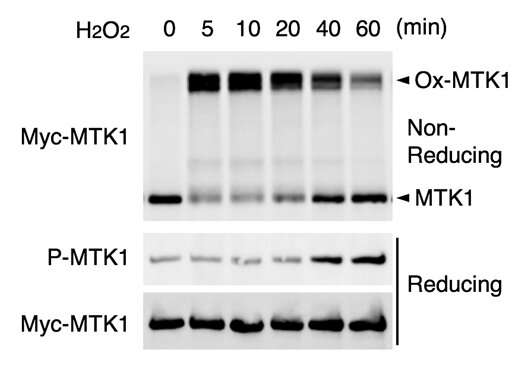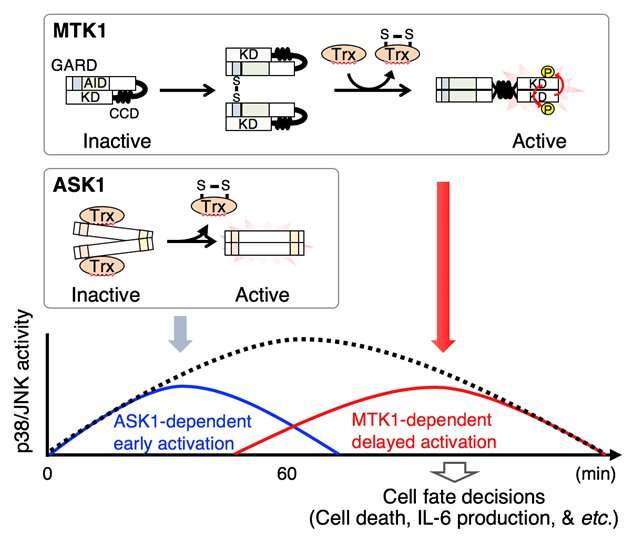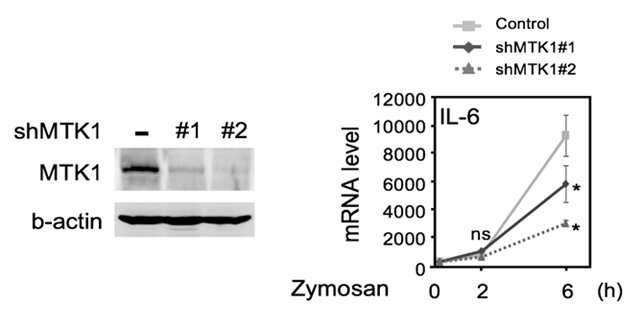Identification of new 'oxidative stress sensor' MTK1

In an aging society, various studies are being conducted to explore the relationship between active oxygen and aging-related diseases such as cancer, chronic inflammatory diseases, and metabolic syndrome.
A research group at the Institute of Medical Science, The University of Tokyo in Japan, led by Professor Mutsuhiro Takekawa, has uncovered a new mechanism that elicits a cellular response by detecting oxidative stress in the human body. MTK1 SAPKKK is identified as a new human oxidative stress sensor that senses excess active oxygen in the body and transmits that information to cells, leading to cell death and inflammatory cytokine production. The results of this research were published in Science Advances on June 24, 2020.
MTK1 SAPKKK perceives the cellular redox state and transduces it into SAPK signaling
Living organisms obtain the energy necessary for life activities by oxygen respiration. However, it is known that reactive oxygen species are generated in the human body as a by-product in the process.
Overproduction of active oxygen causes damage to cells and causes various diseases such as aging, cancer, chronic inflammatory diseases (rheumatoid arthritis, etc.), metabolic syndrome, and neurodegenerative diseases. Therefore, it is thought that the human body is equipped with a mechanism for sensing and appropriately responding to the oxidative stress state caused by overproduction of active oxygen. However, the detailed mechanism was unknown.

Cells respond to oxidative stress by inducing intracellular signaling, including the stress-activated p38 and JNK MAPK (SAPK) pathways, but the underlying mechanisms remain unclear. The research team reports that MTK1 SAPKKK functions as an oxidative stress sensor that perceives the cellular redox state and transduces it into SAPK signaling.
Following oxidative stress, MTK1 is rapidly oxidized and subsequently gradually reduced at evolutionarily conserved cysteine residues. These coupled oxidation-reduction modifications of MTK1 elicit its catalytic activity.
Gene knockout experiments showed that oxidative stress-induced SAPK signaling is mediated by coordinated activation of the two SAPKKKs, MTK1 and ASK1, which have different time and dose response characteristics.
They found that the MTK1-mediated redox sensing system is crucial for delayed and sustained SAPK activity and dictates cell fate decisions including cell death, and IL-6 production during respiratory burst in macrophages. Their results delineate a molecular mechanism by which cells generate optimal biological responses under fluctuating redox environments.
For details of the research, please see the paper.

Application to the treatment of cancer, metabolic syndrome
Professor Takekawa, at the Institute of Medical Science, the University of Tokyo, says, "This study has revealed a part of the oxidative stress response mechanism of the human body. The Cys residue in the MTK1 molecule, which is important for its function as an oxidative stress sensor, is highly conserved not only in humans but also in a wide variety of vertebrates, and the MTK1-mediated oxidative stress response is also evolutionarily conserved. This is strongly suggestive that the mechanism is common to various vertebrates."
The research group hopes that the findings of this research will be used in the future to develop therapeutic agents for various diseases related to reactive oxygen species such as cancer, chronic inflammatory diseases, and metabolic syndrome. These results were obtained as a cooperative effort with Professor Hiroaki Miki at Research Institute for Microbial Diseases, Osaka University in Japan.
More information: Moe Matsushita et al, Stress-responsive MTK1 SAPKKK serves as a redox sensor that mediates delayed and sustained activation of SAPKs by oxidative stress, Science Advances (2020). DOI: 10.1126/sciadv.aay9778
Journal information: Science Advances
Provided by University of Tokyo





















